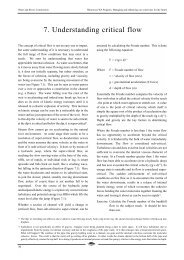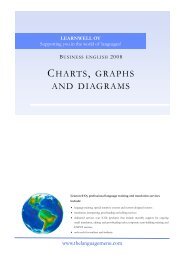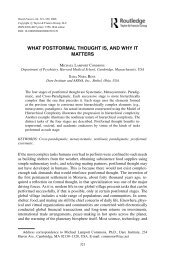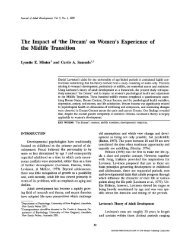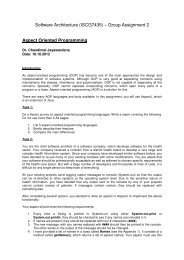Moral Development and Moral Education: An Overview
Moral Development and Moral Education: An Overview
Moral Development and Moral Education: An Overview
Create successful ePaper yourself
Turn your PDF publications into a flip-book with our unique Google optimized e-Paper software.
Within domain theory a distinction is drawn between the child's developing concepts of morality,<br />
<strong>and</strong> other domains of social knowledge, such as social convention. According to domain theory, the<br />
child's concepts of morality <strong>and</strong> social convention emerge out of the child's attempts to account for<br />
qualitatively differing forms of social experience associated with these two classes of social events.<br />
Actions within the moral domain, such as unprovoked hitting of someone, have intrinsic effects (i.e.,<br />
the harm that is caused) on the welfare of another person. Such intrinsic effects occur irregardless of<br />
the nature of social rules that may or may not be in place regarding the action. Because of this, the<br />
core features of moral cognition are centered around considerations of the effects which actions have<br />
upon the well-being of persons. <strong>Moral</strong>ity is structured by concepts of harm, welfare, <strong>and</strong> fairness.<br />
In contrast, actions that are matters of social convention have no intrinsic interpersonal<br />
consequences. For example, there is nothing intrinsic to the forms of address we employ that makes<br />
calling a college teacher "professor" better or worse than calling the person Mr. or Ms., or simply<br />
using their given names. What makes one form of address better than another is the existence of<br />
socially agreed upon rules. These conventions, while arbitrary in the sense that they have no<br />
intrinsic status, are nonetheless important to the smooth functioning of any social group. Conventions<br />
provide a way for members of the group to coordinate their social exchanges through a set of agreed<br />
upon <strong>and</strong> predictable modes of conduct. Concepts of convention then, are structured by the child's<br />
underst<strong>and</strong>ings of social organization.<br />
These hypothesized distinctions have been sustained through studies over the past 20 years.<br />
These studies have included interviews with children, adolescents <strong>and</strong> adults; observations of childchild<br />
<strong>and</strong> adult-child social interactions; cross-cultural studies; <strong>and</strong> longitudinal studies examining the<br />
changes in children's thinking as they grow older. <strong>An</strong> example of the distinction between morality <strong>and</strong><br />
convention is given in the following excerpt from an interview with a four-year-old girl regarding her<br />
perceptions of spontaneously occurring transgressions at her preschool.<br />
MORAL ISSUE: Did you see what happened? Yes. They were playing <strong>and</strong> John hit him too hard.<br />
Is that something you are supposed to do or not supposed to do? Not so hard to hurt. Is there a rule<br />
about that? Yes. What is the rule? You're not to hit hard. What if there were no rule about hitting hard,<br />
would it be all right to do then? No. Why not? Because he could get hurt <strong>and</strong> start to cry.<br />
CONVENTIONAL ISSUE: Did you see what just happened? Yes. They were noisy. Is that<br />
something you are supposed to or not supposed to do? Not do. Is there a rule about that? Yes. We<br />
have to be quiet. What if there were no rule, would it be all right to do then? Yes. Why? Because<br />
there is no rule.<br />
<strong>Moral</strong>ity <strong>and</strong> convention, then, are distinct, parallel developmental frameworks, rather than a<br />
single system as thought of by Kohlberg. However, because all social events, including moral ones,<br />
take place within the context of the larger society, a person's reasoning about the right course of<br />
action in any given social situation may require the person to access <strong>and</strong> coordinate their<br />
underst<strong>and</strong>ings from more than one of these two social cognitive frameworks. For, example, whether<br />
people line up to buy movie theater tickets is largely a matter of social convention. <strong>An</strong>yone who has<br />
traveled outside of Northern Europe or North America can attest to the fact that lining up is not a<br />
shared social norm across cultures. Within the United States or Engl<strong>and</strong>, for example, lining up is the<br />
conventional way in which turn-taking is established. The act of turn-taking has a moral consequence.<br />
It establishes a mechanism for sharing - an aspect of distributive justice. The act of breaking in line<br />
within the American or British context is more than merely a violation of convention. It is a violation of<br />
a basic set of rules that people hold to maintain fairness. How people coordinate the possible<br />
interactions that may arise between issues of morality <strong>and</strong> convention is a function of several factors<br />
including: the salience of the features of the act (what seems most important - the moral or<br />
conventional elements); <strong>and</strong> the developmental level of the person (adolescents for example view<br />
conventions as unimportant <strong>and</strong> arbitrary norms established by adult authority).<br />
It was Turiel's insight to recognize that what Kohlberg's theory attempts to account for within a<br />
single developmental framework is in fact the set of age-related efforts people make at different<br />
points in development to coordinate their social normative underst<strong>and</strong>ings from several different<br />
domains. Thus, domain theory posits a great deal more inconsistency in the judgments of individuals<br />
across contexts, <strong>and</strong> allows for a great deal more likelihood of morally (fairness <strong>and</strong> welfare) based<br />
decisions from younger <strong>and</strong> less developed people than would be expected from within the traditional<br />
Kohlberg paradigm.






